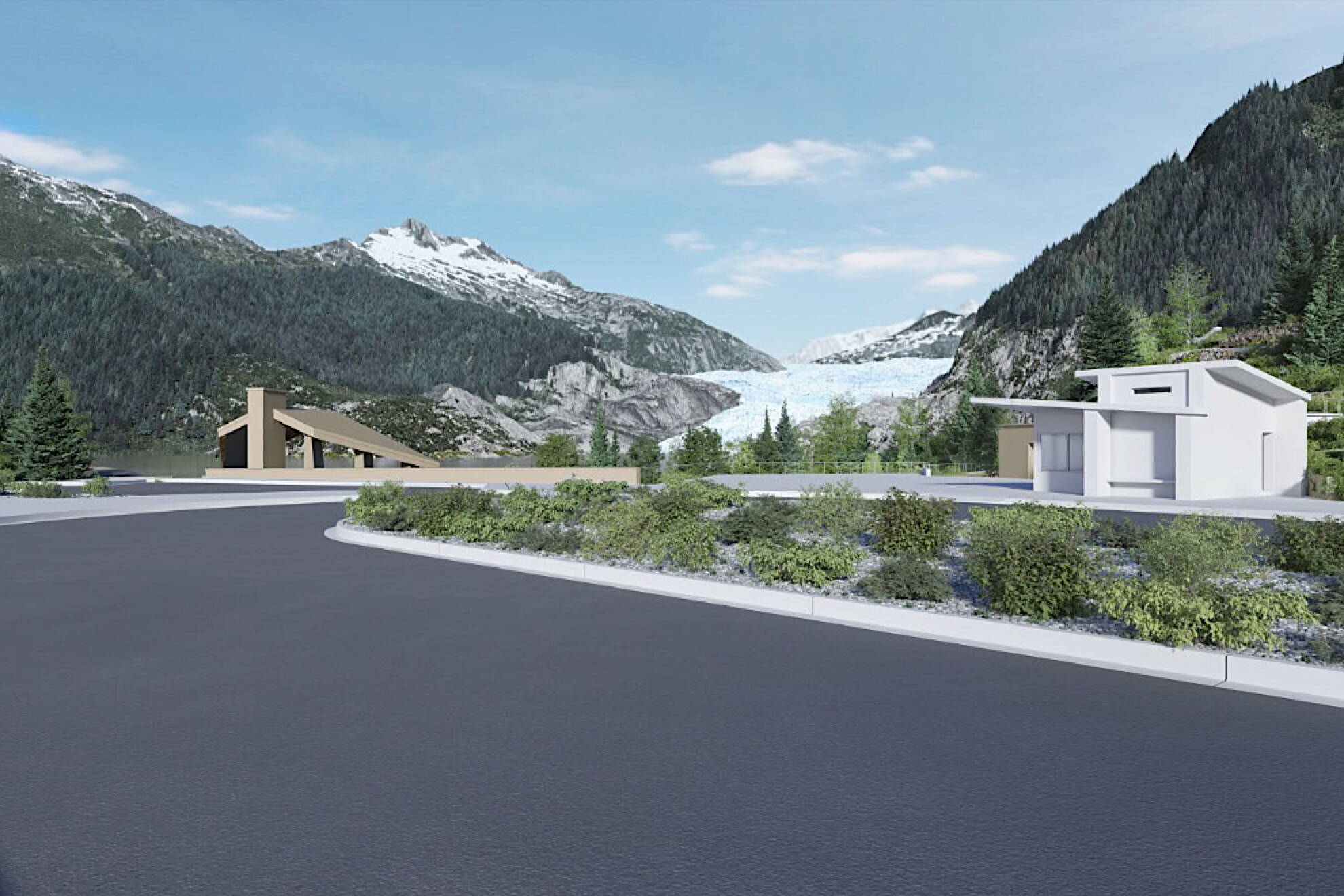This is a developing story.
A final Record of Decision for a multiyear improvement plan at the Mendenhall Glacier Recreation Area was published Thursday, clearing the way after about four years of public review for projects to begin for the U.S. Forest Service area that receives about 700,000 visitors annually.
The 83-page decision features a new welcome center and outdoor amphitheater, more parking, expanded trail access and up to five new public-use cabins. It also states motorized boats will not be allowed on Mendenhall Lake and rejects a proposed visitor center near the current face of the glacier, which has receded considerably since the existing center was built.
“This decision reflects the substantial public input we received from the community, considerations from tribal consultations, and the exhaustive work of analyzing the diverse ecosystems of the Mendenhall Recreation Area,” said Tongass National Forest Supervisor Frank Sherman in a prepared statement. “We received hundreds of comments through five separate public engagements which significantly improved the final plan.”
The Notice of Decision comes as the recreational area is tangled in a couple of political hotbed disputes about access. Gov. Mike Dunleavy is suing to seize control of Mendenhall Lake and Mendenhall River from the federal government, which among other things would allow motorized vessels to be used on the waters. At the local level, tour companies have been forced to turn away customers due to commercial tourism limits being reached, with related impacts including city busses being full to capacity with visitors as local residents were left stranded.
Among the stated hopes for the improvement plan are better and more flexible control of an area expected to see about a million visitors a year 30 years from now.
The plan’s final Environmental Impact Statement published in May contained seven alternatives. During a subsequent 45-day response period 17 objections were received, and Sherman stated he and another official met with 12 of the people objecting on Aug. 1 to discuss specific concerns which were factored in along with other review in the final document.
The Notice of Decision “documents my decision to implement a combination of project components from the alternatives,” Sherman wrote.
A new Welcome Center up to 14,000 square feet in size, for instance, is being relocated to the site of the existing commercial overflow parking lot instead of closer to the glacier viewing area, along with associated plazas, parking and access areas, according to the decision.
“A small plaza area will be constructed adjacent to the Welcome Center and will include benches, interpretive signs, and a covered shelter(s) to accommodate visitors near the bus and electric shuttle pick-up/drop-off areas and the Welcome Center,” the decision states.
A new sewer system at the Welcome Center “able to accommodate anticipated visitation over the duration of the project” is also planned.
Once the Welcome Center is complete, commercial vehicle parking and staging will be shifted south to an area large enough to accommodate about 40 buses, 20 guide vans, six for-hire/rideshare vehicles, three standard vehicles and one ADA-accessible space, according to Sherman. There will also be a space for tour bus pickup/dropoff at the front of the Welcome Center serviced by an electric shuttle that will drop visitors off near Zig Zag Pond.
“It is not anticipated that all visitors arriving at the Welcome Center will use the electric shuttle; many may choose to walk to the Visitor Center and lakeshore area via the expanded Steep Creek Trail,” Sherman wrote.
The historic Visitors Center will increase office space on the lower floor by moving an external wall about 200 feet out under an existing roof overhang, thus not increasing the building’s footprint size, according to the decision. The upper floor will be renovated to upgrade visitor offerings.
“Hands-on exhibits will be added and the theater space will be redesigned,” the decision notes. “Renovations to the original observatory portion of the upper floor will help return the experience of the space to the Visitor Center’s 1960s character. Additional improvements will be made to the outside railing and trail surface leading up to the Visitor Center to match the new plaza areas and to provide a safer route for visitors. A new covered area outside the main upper doors will provide shelter from the weather upon entry and exit.”
In his introduction, Sherman stated the decision also includes:
• Realigning, regrading and restoring about 1,500 feet of the Steep Creek stream channel located downstream (west) of the Glacier Spur Road to improve salmon habitat, and develop an appropriate floodplain with a balanced movement of creek substrates. “The channel will be relocated 30 to 200 feet west of its current location and regraded to a low gradient of just over 1% to facilitate fish movement.”
• Construction, improvement, or designation of the Lakeshore, Nugget Falls, Steep Creek, and West Glacier Spur trails, and the Dredge Lake and West Glacier unit multi-use trails.
• Construction of up to five new public-use cabins.
“In addition to those specific facility improvements, this decision also includes installation of culverts or other required drainage structures, grading, removal of outdated infrastructure and materials, vegetation management to preserve views, revegetation, and other maintenance of facilities and trails,” Sherman wrote.
According to Sherman, the decision does not:
• Allow for development of boat docks and related support facilities, but “the existing non-motorized boat launch areas north of the Welcome Center Complex and near Skater’s Cabin will remain.”
• Allow motorized boat use on the lake.
• Include a remote glacier visitor area. “No development will occur on the north side of the lake except for the West Glacier Trail and the West Glacier Spur Trail.”
• Make any changes to travel management or motor vehicle use maps, or allow for electric bike use on non-motorized trails.
• Contact Mark Sabbatini at mark.sabbatini@juneauempire.com or (907) 957-2306.

